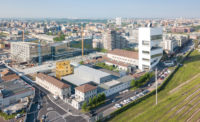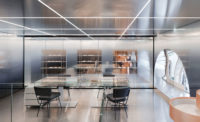The Rem Koolhaas of such monumental buildings as the CCTV tower'which looms over central Beijing'is gone, replaced by a Rem Koolhaas who wants his buildings to blend in. As director of the Venice Architecture Biennale in 2014, Koolhaas suggested that he was tired of architectural pyrotechnics. Now comes the Prada Foundation, a 100-year-old distillery complex turned contemporary art center. It boasts some 120,000 square feet of exhibition space (more than Renzo Piano's new Whitney Museum), much of that in new buildings. But Koolhaas repeatedly described the project as if it were just a renovation.
But can Koolhaas be a background architect? Can Beyonc' be a backup singer? If not quite CCTV, the Prada Foundation is a spectacular display of architectural prowess. And it is precisely the contrast between old and new'as when a giant steel beam supporting the second floor of a new gallery seemingly comes to rest on the wall of a quaint stucco building with a red-tile roof'that makes this art venue exciting. He may have wanted to create a seamless mix, but Koolhaas's architecture is too striking to be mistaken for anything but Koolhaas's architecture.
The client is a foundation created by Mrs. Prada (as she is generally known) and her husband, Patrizio Bertelli, who together rule the fashion empire. In their spare time, the pair collects contemporary art, which the foundation has shown in a Venetian palazzo and at a variety of sites around Milan. In 2008, they decided to build a permanent home for their collection in Milan and brought in Koolhaas's OMA, with which they first began collaborating 15 years ago on a series of high-profile Prada stores.
The complex OMA created, covering 3.3 acres, comprises seven buildings. Two existing low-rise structures bracket the site; they now contain enfilades of galleries, along with event spaces and offices. (Another perimeter building houses a caf', which was designed by the movie director Wes Anderson and is described by Koolhaas as a self-contained 'insert.')
Between the perimeter buildings are two large new structures. One is a huge glass-walled gallery called the Podium, which is almost Miesian in its simplicity, though its vertical surfaces are composed of aluminum foam whose bubble patterns counter the spareness of the architecture.
Another new creation is a 200-seat theater that Koolhaas partially covered in stucco, as if to suggest that it had been there all along. But this is a high-tech marvel inside and out, with a long wall of mirror-polished stainless steel that opens up, garage-door style. That allows indoor theatrical events to happen, essentially, under the stars (an idea Koolhaas explored, less successfully, at the Wyly Theater in Dallas).
A third new building, a large nine-story tower, is still under construction: it will contain additional gallery space, as well as a restaurant. (When complete, the buildings will encompass more than 200,000 square feet. Neither architect nor client will reveal anything about the budget.)
At the center of the complex is a diminutive tower, part of the original complex that was in such bad shape that Koolhaas took to calling it the haunted house. Almost at the last minute, Koolhaas said, he had the idea to cover that tower'every inch of it, including downspouts and window mullions'in gold leaf. The gold, he said, is 'a surprisingly effective way to distribute aura around the site,' adding that, in the way it reflects light, 'it has benefits we didn't anticipate.'
Indeed, Koolhaas said, there are many things about the complex that surprised him when the scaffolding came down. One is that with just a few gestures he was able to create very different outdoor spaces, from narrow alleyways to broad plazas. The variety in both dimensions and surface treatments makes visitors want to hang around and explore the foundation's exterior as much as its interior spaces.
In recent years, Koolhaas has been speaking about historic preservation, seemingly complaining that there is too much of it while praising it as a refuge from the need to continuously create new forms. At the Prada Foundation, that contradiction is made manifest.
Overall, the modest new Koolhaas seems to be attributing much of the success of the complex to luck rather than talent. A terrace atop one of the perimeter buildings, he said, far exceeded his expectations. 'It's just a floor and railing,' he said, urging a reporter to be sure to check it out (and ignoring the fact that its floor is made of extraordinarily beautiful travertine). 'It's really surprising,' Koolhaas added, 'how little you need to create architectural space.'
PeopleClient: Fondazione Prada Architect: Rem Koolhaas, Chris van Duijn, partners in charge Personnel who should receive special credit: Engineers: M/E/P: Favero & Milan, Prisma Engineering Fire: GAE Engineering Consultants: General Contractor: Colombo Costruzioni Photographers: Size: 203,000 square feet Cost: withheld Completion Date: May 2015 |
ProductsExterior Cladding Mirror cladding: AZA Aghito Zambonini Travertine: Fantini Group Gold leaf: Teknolitos Lighting:
|




























Post a comment to this article
Report Abusive Comment